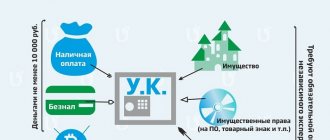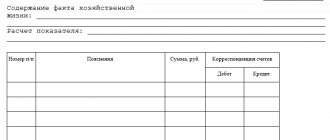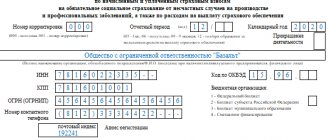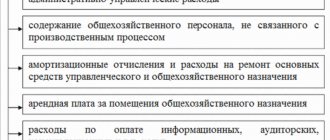Many financiers are faced with the need to develop and implement management accounting in an enterprise. We can say that this is a kind of test for professional aptitude: if you succeed in building accounting, you can be considered a highly qualified specialist; if you fail, you do not understand the finances of the enterprise well enough. In this article we will look at an important aspect of constructing management accounting - forms of management reporting, and we will figure out which forms to use in a particular business, how to build and automate them.
Income statement
This is perhaps the most important management report. It reflects information about the actual profit/loss of the enterprise.
The form of the financial results report (form No. 2) of the financial statements was approved by Order of the Ministry of Finance of Russia dated July 2, 2010 No. 66n (as amended on April 6, 2015) “On the forms of financial statements of organizations” and has a fairly detailed form.
In a management report, it is permissible to both group some lines of the report and, conversely, provide a more detailed breakdown (primarily this concerns the company’s expenses).
The final recipients of the document can also request detailed information on revenue (for example, broken down by type of product).
A fragment of the management report on financial results is in table. 1.
Table 1
Fragment of the management report on financial results, thousand rubles.
| Name | Meaning |
| Revenue | 68 074 |
| Cost of sales | 56 616 |
| Gross profit (loss) | 11 458 |
| Profit (loss) from sales | 11 458 |
| Percentage to be paid | 362 |
| other expenses | 1018 |
| Profit (loss) before tax | 10 078 |
| Current income tax | 2016 |
| Net income (loss) | 8062 |
The main thing we see from this report is the positive financial result of the enterprise: revenue exceeds the costs the enterprise incurred to produce and sell products.
However, every company constantly strives to increase profits. To do this, as a rule:
- increase the selling price per unit of production (which, as a consequence, increases the amount of revenue);
- reduce the cost of sales (with a constant amount of revenue, this increases profit, including profit per unit of production).
When planning financial results based on management reporting, actual and planned sales volumes are taken into account. Such planning is quite conditional, since the cost of sales includes both fixed and variable costs, and the former practically do not change with an increase or decrease in sales volume.
We will carry out preliminary calculations to draw up a planned report on financial results.
We know that revenue in the amount of 68,074 thousand rubles. received from sales of 257 units. products at a price of RUB 264,880.00. per unit (the analyzed enterprise produces one type of product).
In the next reporting period, it is planned to sell 294 units.
Thus, the planned revenue will be 77,875 thousand rubles. (RUB 264,880.00 × 294 pcs.) at a cost of RUB 64,767 thousand. (RUB 220,295.70 × 294 pcs.).
Forecast report on financial results - in table. 2.
table 2
Forecast report on financial results, thousand rubles.
| Name | Meaning |
| Revenue | 77 875 |
| Cost of sales | 64 767 |
| Gross profit (loss) | 13 108 |
| Profit (loss) from sales | 13 108 |
| Percentage to be paid | 362 |
| other expenses | 1018 |
| Profit (loss) before tax | 11 728 |
| Current income tax | 2346 |
| Net income (loss) | 9382 |
With such planning, profitability indicators (products, enterprise, sales, etc.) remain unchanged, because forecasting takes into account only fluctuations in sales volume.
Let's calculate the main profitability indicators that characterize the profitability of the enterprise and the economic feasibility of its activities.
Profitability of core activities (R1) is the ratio of profit before tax to revenue from product sales. This ratio shows what part profit is in revenue.
Conventionally, the normative value is considered to be 10–15%.
In our case, R1 = 10,078 / 68,074 × 100% = 11,728 / 77,875 × 100% = 15%.
The higher the profit margin in relation to revenue, the more profitable the enterprise is considered.
Product profitability (R2) is the ratio of net profit to total cost. This indicator is very important for analyzing the efficiency of activities: it shows how profitable the products produced are, how much profit the enterprise received from the total costs of its production.
In our case, R2 = 8062 / 56,616 × 100% = 9382 / 64,767 × 100% = 15%.
For your information
At the stage of analyzing management reporting and planning activities in the short or long term, it is possible to identify problem areas, such as high enterprise costs for production, low revenue, etc.
Based on the results of the analysis, they formulate a policy for the further development of the enterprise, make decisions, for example, on abandoning the production of any type of product, on expanding the sales market, optimizing costs, increasing/lowering the retail price, etc.
How are financial statements prepared and maintained?
Financial reporting indicators are formed in the accounting system.
The cycle of accounting work for any month in the inter-reporting period is divided into three stages :
- Processing of primary documents (registers of primary documents) submitted by financially responsible persons, formation of cumulative and grouping statements.
- Systematization of primary documents in accounting registers.
- Collection of information about accounting objects in the General Ledger accounts according to the final indicators of accounting registers. General Ledger indicators (debit and credit turnovers, balances) are required for accounting reporting. If necessary, data from analytical accounting registers can be used.
The procedure for maintaining financial statements includes:
- checking entries in accounting accounts, eliminating errors;
- clarification of the assessment of assets and liabilities present in accounting;
- reflection of the financial results of the company;
- filling out reporting forms.
Well-known methods will help to check the completeness and absence of errors in the entries in the accounting accounts, the choice of which depends on the form of accounting used.
Most often, entries in accounting accounts are checked in the following areas:
- compare the turnover for each synthetic account with the results of the documents that form the basis for the entries;
- compare turnovers and balances for all synthetic accounts (in total);
- compare turnovers and balances for each synthetic account with the corresponding figures of analytical accounting.
To compare turnovers and balances on all synthetic accounts, a balance sheet is prepared.
Managerial balance
The form of the management balance sheet is not approved at the legislative level, so we recommend using the form of the usual balance sheet.
For your information
Depending on the wishes of the end user, you can remove unnecessary balance sheet lines, group individual items or, conversely, describe them in detail (for example, borrowed funds, if their share in the balance sheet currency is significant).
An example of a managerial balance sheet is in table. 3.
Table 3
Management balance, thousand rubles.
| Assets | Meaning |
| I. Non-current assets | |
| Intangible assets | 3 |
| Fixed assets | 4803 |
| Total for Section I | 4806 |
| II. Current assets | |
| Reserves | 14 390 |
| Accounts receivable | 22 422 |
| Cash and cash equivalents | 4063 |
| Total for Section II | 40 875 |
| BALANCE | 45 681 |
| PASSIVE | |
| III. Capital and reserves | |
| Authorized capital | 86 |
| Reserve capital | 14 |
| Retained earnings (uncovered loss) | 10 942 |
| Total for Section III | 11 042 |
| IV. long term duties | 0 |
| Total for Section IV | 0 |
| V. Current liabilities | |
| Borrowed funds | 550 |
| Accounts payable | 34 089 |
| Total for Section V | 34 639 |
| BALANCE | 45 681 |
We made the usual form of the balance sheet simpler - we removed items with zero values, with the exception of section IV, in order to focus on the fact that the company has no long-term liabilities.
Based on the management balance sheet, the main indicators of the financial condition of the enterprise are calculated. At this stage, a comprehensive analysis of reporting is not needed - it is enough to focus on the problem areas of the enterprise:
The equity ratio (EFR) is calculated as the ratio of the difference between equity capital and non-current assets to current assets:
CMRR = (Total for Section III – Total for Section I) / Total for Section II,
in our example, CMRR = (11,042 – 4,806) / 40,875 = 0.15.
The value of the indicator indicates an unsatisfactory balance sheet structure and a high probability of insolvency of the enterprise as a whole.
An indicator value greater than 0.5 indicates the good financial condition of the enterprise and its ability to pursue an independent financial policy.
The debt ratio (Кз) is calculated as the ratio of the enterprise's total debts to its own funds:
Кз = (Total for Section IV + Total for Section V) / Total for Section III;
at the analyzed enterprise Kz = 34,639 / 11,042 = 3.14.
The standard value of the indicator is below 1. Otherwise, the amount of borrowed funds exceeds own funds.
Based on the results obtained, it is possible to predict the balance sheet model for the next reporting period, for example, using the percentage of sales method.
To compile it, you need the following data:
- about actual sales for the reporting period (for our example - 257 units), for which the management balance sheet was compiled;
- about the planned sales volume in the next period (for our example - 294 units).
The coefficient of change in sales volume (Kizm) is calculated as follows:
Kism = Q2 / Q1,
where Q1 is the volume of product sales for the previous period, pcs.;
Q2 - volume of product sales for the planned period, pcs.,
in our case Kiz = 294 / 257 = 1.144.
The amount of net profit according to the forecast (see Table 2) is 9382 thousand rubles. provided that the company will not distribute profits as dividends due to the high level of short-term liabilities that need to be repaid.
Net profit can be used, for example, to increase retained earnings (RUB 5,486 thousand) and to pay off liabilities (RUB 3,896 thousand).
Based on this methodology, we will draw up a forecast balance (Table 4).
Table 4
Forecast balance, thousand rubles.
| Assets | Meaning |
| I. Non-current assets | |
| Intangible assets | 3 |
| Fixed assets | 5495 |
| Total for Section I | 5498 |
| II. Current assets | |
| Reserves | 16 462 |
| Accounts receivable | 25 651 |
| Cash and cash equivalents | 4648 |
| Total for Section II | 46 761 |
| BALANCE | 52 259 |
| PASSIVE | |
| III. Capital and reserves | |
| Authorized capital | 86 |
| Reserve capital | 14 |
| Retained earnings (uncovered loss) | 16 428 |
| Total for Section III | 16 528 |
| IV. long term duties | 0 |
| Total for Section IV | 0 |
| V. Current liabilities | |
| Borrowed funds | 629 |
| Accounts payable | 35 102 |
| Total for Section V | 35 731 |
| BALANCE | 52 259 |
Based on the proposed changes, we will calculate the coefficients:
KOSS = (16,528 – 5,498) / 46,761 = 0.24;
Kz = 35,731 / 16,528 = 2.16.
So, thanks to the measures formed on the basis of management reporting, it was possible to increase the enterprise’s independence from borrowed sources of financing and improve the ratio of equity and borrowed funds.
To consolidate the effect, it is worth analyzing the profitability of the enterprise and finding an opportunity to increase the level of profit to strengthen financial independence.
Income and Expense Report
The income and expense report allows you to analyze the volume of cash flows, revenue from sales of products and costs of their production and sale, and calculate coefficients characterizing the business activity and financial stability of the enterprise.
First, the enterprise prepares a planning document on future income and expenses, and based on it, an actual management report. On its basis, planned and actual indicators are analyzed.
An example of an income and expense report is presented in table. 5.
Table 5
Management report on income and expenses
| No. | Name of income (expenses) | Plan | Fact |
| 1 | Income | 18 560,00 | 16 704,00 |
| 1.1 | Advance to Beta LLC | 7424,00 | 7424,00 |
| 1.2 | Advance payment to Gamma LLC | 2438,40 | 2438,40 |
| 1.3 | Advance to Omega LLC | 4985,60 | 4985,60 |
| 1.4 | Final settlement of Beta LLC | 1856,00 | 1856,00 |
| 1.5 | Final settlement of Gamma LLC | 609,60 | 0,00 |
| 1.6 | Final settlement of Omega LLC | 1246,40 | 0,00 |
| 2 | Expenses | 8434,77 | 8415,26 |
| 2.1 | Payment of wages + insurance premiums | 4007,34 | 4383,45 |
| 2.2 | Advance payment to supplier Norman LLC | 1582,45 | 1582,45 |
| 2.3 | Advance payment to supplier Dixit LLC | 1512,00 | 1512,00 |
| 2.4 | Final settlement with the supplier Norman LLC | 395,61 | 0,00 |
| 2.5 | Final settlement with the supplier Dixit LLC | 378,00 | 378,00 |
| 2.6 | Rent | 500,00 | 500,00 |
| 2.7 | Public utilities | 39,72 | 39,72 |
| 2.8 | Telephone and Internet expenses | 11,00 | 11,00 |
| 2.9 | Depreciation deductions | 8,64 | 8,64 |
When presenting management reports to management, you must be prepared to answer questions. For example, if there is no income - “why?” In this case, it is necessary to find out why the funds were not received - there were no shipments, the customer delayed payment, etc.
If the expense portion of the report has changed significantly, you may have to prepare a more detailed report for certain items.
An analysis of the income and expense report will allow you to understand in advance that in a certain period there will not be enough money in the account, for example, for advances to suppliers. Then management will have the opportunity to quickly respond to the situation, for example, agree to postpone the terms of the advance.
Naturally, such reports are constantly adjusted depending on changes in planned payments.
Typical differences in management
To simplify understanding, we will not touch on the specifics of tax accounting; we will only consider the difference between accounting and management accounting.
- Different categorization of expenses
In management accounting, the same costs can be accounted for on a different principle, allocated to several different items, or even referred to as a different expense item. For example, what is considered production expenses in accounting can be considered general economic expenses in management and written off as management expenses.
- Different accounting procedures
Property depreciation and expenses are often reflected differently. For example, what is recorded as deferred expenses (FPR) in accounting can only be taken into account in management accounting in the period when the company incurred the costs.
- Management accounting can be maintained in another currency
A common situation for those who work for foreign clients, have branches in other countries, or are about to enter a new market.
In addition to the difficulties of the simultaneous autonomous functioning of two systems, there are usually problems in each type of accounting separately.
Cash flow statement
The cash flow statement (CFS) contains information about cash flows (according to the current account and/or cash register), reflecting both planned and actual receipts and expenditures of funds.
The structure is similar to the cash flow budget (CFB), the distinctive feature is the presence of actual indicators characterizing the execution of the budget.
ODDS allows you to assess the financial capabilities of an enterprise, monitor the availability of funds in the account and in the cash register of the enterprise, balance the receipts and expenditures of funds, and therefore control the liquidity and solvency of the enterprise.
ODDS, like BDDS, includes cash flows from current investment and financial transactions.
Current cash flows are revenues from sales of products, rental payments, expenses for paying for the services of suppliers and contractors, wages for employees of the enterprise, tax payments, etc.
Investment cash flows are transactions associated with the acquisition, creation or disposal of non-current assets, for example, costs of development and technological work, loans, payments in connection with the acquisition of shares, etc.
Cash flows from financial transactions include proceeds from operations related to attracting financing (cash deposits, payments in connection with the repurchase of shares, payment of dividends, repayment of bills, etc.).
In order to effectively plan the expenditure and receipt of funds, it is necessary to conduct a plan-factual analysis, especially in a crisis situation, when payment discipline worsens and the enterprise may not have enough money to make payments.
Management ODDS increases the efficiency of planning and budgeting in general.
An example of a cash flow statement is presented in table. 6.
Table 6
Cash flow statement for July 2021, thousand rubles.
| No. | Index | Plan | Fact |
| Cash balance at the beginning of the month | 12 200,00 | 12 200,00 | |
| 1 | Cash receipts | 7400,00 | 7400,00 |
| 1.1 | Income from core activities | 7400,00 | 7400,00 |
| 1.1.1 | Advances from customers | 7400,00 | 7400,00 |
| 1.1.1.1 | Alpha LLC, agreement No. 12 dated January 30, 2017 | 0,00 | 0,00 |
| 1.1.1.2 | Gamma LLC, agreement No. 212/T dated June 28, 2017 | 7400,00 | 7400,00 |
| 1.1.1.3 | Beta LLC, agreement No. 17 dated March 24, 2017 | 0,00 | 0,00 |
| 1.1.2 | Revenue from sales of goods (works and services) | 0,00 | 0,00 |
| 1.1.2.1 | Alpha LLC, agreement No. 12 dated January 30, 2017 | 0,00 | 0,00 |
| 1.1.2.2 | Gamma LLC, agreement No. 212/T dated 04/28/2017 | 0,00 | 0,00 |
| 1.1.2.3 | Beta LLC, agreement No. 17 dated March 24, 2017 | 0,00 | 0,00 |
| 1.1.2.4 | Omega LLC, agreement No. 1 dated December 23, 2016 | 0,00 | 0,00 |
| 1.1.2.5 | Norma LLC, agreement No. 7 dated February 16, 2017 | 0,00 | 0,00 |
| 1.2 | Income from financial activities | 0,00 | 0,00 |
| 1.3 | Receipts from investment activities | 0,00 | 0,00 |
| 2 | Spending money | 7783,05 | 7517,01 |
| 2.1 | Expenses for core activities | 3647,65 | 3204,21 |
| 2.1.1 | Settlements with suppliers | 2319,05 | 1749,51 |
| 2.1.1.1 | Calculations for components | 2319,05 | 1749,51 |
| 2.1.1.1.1 | Product No. 1 | 1174,15 | 604,61 |
| 2.1.1.1.1.1 | Plant named after I. I. Ivanova | 0,00 | 0,00 |
| 2.1.1.1.1.2 | JSC "Alfa" | 268,85 | 0,00 |
| 2.1.1.1.1.3 | LLC "Diagonal" | 500,69 | 200,00 |
| 2.1.1.1.1.4 | JSC "Yaroslavl" | 0,00 | 0,00 |
| 2.1.1.1.1.5 | Other suppliers | 404,61 | 404,61 |
| 2.1.1.1.2 | Product No. 2 | 1144,90 | 1144,90 |
| 2.1.1.1.1.1 | Plant named after I. I. Ivanova | 0,00 | 0,00 |
| 2.1.1.1.1.2 | JSC "Alfa" | 588,00 | 588,00 |
| 2.1.1.1.1.3 | LLC "Diagonal" | 0,00 | 0,00 |
| 2.1.1.1.1.4 | Other suppliers | 556,90 | 556,90 |
| 2.1.2 | Salary | 1022,00 | 1119,00 |
| 2.1.2.1 | Division No. 1 (Moscow) | 476,00 | 512,00 |
| 2.1.2.2 | Division No. 2 (St. Petersburg) | 546,00 | 607,00 |
| 2.1.3 | Insurance premiums | 306,60 | 335,70 |
| 2.1.3.1 | Division No. 1 (Moscow) | 142,80 | 153,60 |
| 2.1.3.2 | Division No. 2 (St. Petersburg) | 163,80 | 182,10 |
| 2.2 | General running costs | 3068,00 | 3202,60 |
| 2.2.1 | Division No. 1 (Moscow) | 625,00 | 717,60 |
| 2.2.1.1 | Rent | 75,00 | 75,00 |
| 2.2.1.2. | Communication services | 3,00 | 3,00 |
| 2.2.1.3 | Security | 0,00 | 0,00 |
| 2.2.1.4 | Wages (account 26) | 340,00 | 412,00 |
| 2.2.1.5 | Insurance premiums (account 26) | 102,00 | 123,60 |
| 2.2.1.6 | Consumables, office equipment | 0,00 | 12,00 |
| 2.2.1.7 | Fare | 55,00 | 55,00 |
| 2.2.1.8 | other expenses | 50,00 | 37,00 |
| 2.2.2 | Division No. 2 (St. Petersburg) | 2443,00 | 2485,00 |
| 2.2.2.1 | Rent | 275,00 | 275,00 |
| 2.2.2.2 | Communication services | 15,00 | 17,00 |
| 2.2.2.3 | Security | 0,00 | 0,00 |
| 2.2.2.4 | Wages (account 26) | 1610,00 | 1670,00 |
| 2.2.2.5 | Insurance premiums (account 26) | 483,00 | 501,00 |
| 2.2.2.6 | Consumables, office equipment | 0,00 | 0,00 |
| 2.2.2.7 | Transport maintenance costs | 10,00 | 10,00 |
| 2.2.2.8 | other expenses | 50,00 | 12,00 |
| 2.3 | General production expenses | 1067,40 | 1110,20 |
| 2.3.1 | Division No. 1 (Moscow) | 361,90 | 369,20 |
| 2.3.1.1 | Wages (account 25) | 263,00 | 284,00 |
| 2.3.1.2 | Insurance premiums (account 25) | 78,90 | 85,20 |
| 2.3.1.3 | Tools, materials for industrial purposes | 10,00 | 0,00 |
| 2.3.1.4 | other expenses | 10,00 | 0,00 |
| 2.3.2 | Division No. 2 (St. Petersburg) | 705,50 | 741,00 |
| 2.3.2.1 | Wages (account 25) | 535,00 | 570,00 |
| 2.3.2.2 | Insurance premiums (account 25) | 160,50 | 171,00 |
| 2.3.2.3 | other expenses | 10,00 | 0,00 |
| 2.4 | Taxes | 0,00 | 0,00 |
| 2.4.1 | VAT | 0,00 | 0,00 |
| 2.4.2 | Income tax | 0,00 | 0,00 |
| 2.4.3 | Property tax | 0,00 | 0,00 |
| 2.5 | Expenses from financial activities | 0,00 | 0,00 |
| 2.6 | Expenses for investment activities | 0,00 | 0,00 |
| Cash flow from core activities | –383,05 | –117,01 | |
| Cash flow from financial activities | 0,00 | 0,00 | |
| Cash flow from investment activities | 0,00 | 0,00 | |
| Cash surplus/shortage at the end of the month | –383,05 | –117,01 | |
| Cash balance at the end of the month | 11 816,95 | 12 082,99 |
The first thing a manager or other end user of the ODDS will pay attention to is the negative value of the cash flow indicator.
For your information
Cash flow is a calculated indicator for each type of cash flow (current, financial and investment activities), representing the difference between cash receipts and expenditures.
A negative cash flow value indicates that cash receipts are lower than expenditures. And if the business had no cash balance from the previous month, it would not be able to make payments.
In the example, ODDS is presented broken down by manufactured products and separate divisions (Moscow and St. Petersburg). Management may require a more detailed breakdown, for example, if plans differ significantly from actuals.
Based on the cash flow, for example, for a month, cash flows for the next month are predicted, taking into account expected receipts.
Analysis of actual cash expenditures for a month allows you to classify expenses from the point of view of consistency and commitment, to form a certain “constant”, i.e., the amount of cash expenditure that is necessary monthly.
Based on the payment registers and payment calendars in terms of receipts of advances and final payments from customers, the revenue part of the ODDS is formed.
Such cash flow planning ensures efficient cash flow management.
Note!
Plan-actual analysis of the cash balance allows you to set a limit on the cash balance at the end of the month in order to ensure the solvency of the enterprise at the beginning of the next reporting month and in the event of insolvency of counterparties.
Deadlines for submitting annual reports
Article 23 of the Tax Code of the Russian Federation states that organizations are required to submit annual financial statements to the Federal Tax Service no later than March 31 of the year following the reporting year.
If March 31st falls on a Saturday or Sunday, then you can submit reports on the following Monday. In 2021, this day falls on a Friday, so there will be no postponement.
Since you can submit a report in different ways, the question arises of how exactly the date of submission of the report will be calculated:
- If the reporting is sent by mail in a valuable letter with a description of the attachment, this date is considered the day of its mailing. It is indicated on the postmark placed by the postal worker on the inventory of the attachment.
- If the reporting is submitted in person, this date is considered to be the date of its submission. The tax officer must indicate this date on a copy of the reporting or a copy thereof, which remains with the taxpayer. The date is put together with a signature from an employee of the Federal Tax Service, confirming that the tax authority has received a report from the organization.
- If the reporting is submitted electronically, the date of dispatch is considered to be the date indicated in the confirmation of dispatch, i.e. in an electronic document generated by a telecom operator or tax authority.
IMPORTANT! There is no need to submit interim accounting reports (for a quarter or a month) to the tax office.
Report on the actual cost of production
One of the main tasks of each enterprise is to form a market price such that it covers the costs of producing the products sold, while being competitive, consistent with the quality of the products and ensuring market demand.
After a market or contract fixed price has been formed, it is necessary to try to maintain the cost - if the cost exceeds the price, the enterprise will not make a profit. You can control the situation using a management report on the actual cost of production (Table 7).
Table 7
Report on the actual cost of production, rub.
| No. | Costing item | Plan | Fact | Changes, +/– |
| 1 | Material costs | 54 000,00 | 54 361,00 | 361,00 |
| 2 | Labor costs for key production workers | 74 000,00 | 74 254,00 | 254,00 |
| 3 | Insurance premiums | 22 200,00 | 22 276,20 | 76,20 |
| 4 | General production expenses | 27 000,00 | 27 761,80 | 761,80 |
| 5 | General running costs | 41 000,00 | 41 642,70 | 642,70 |
| 6 | Production cost | 218 200,00 | 220 295,70 | 2095,70 |
| 7 | Non-production expenses | 0,00 | 0,00 | 0,00 |
| 8 | Full cost | 218 200,00 | 220 295,70 | 2095,70 |
| 9 | Profit | 46 680,00 | 44 584,30 | –2095,70 |
| 10 | Price excluding VAT | 264 880,00 | 264 880,00 | 0,00 |
This report reflects deviations of planned costing indicators from actual ones. And if they are significant, additional analysis is needed to determine the reasons.
As a rule, at this stage of compiling management reporting, they also establish a group of costs that have the largest share in the cost structure and, on the basis of this, formulate a cost reduction policy to increase product profitability. For example, in order to reduce material costs, they renegotiate contracts with suppliers on more favorable terms or look for new ones; in order to reduce the wage fund, they reduce the number of workers, attract third-party organizations to carry out work, etc.
Taking into account measures to optimize the cost structure, an updated structure is planned for the next reporting period.
Let's consider an example of drawing up a planned calculation of the cost of production, taking into account the growth in volumes while maintaining general business expenses (as a constant component of the cost structure, regardless of fluctuations in volume) at the same level (Table 8).
Actual general business expenses per unit of production (see Table 7) - 41,642.70 rubles. with a sales volume of 257 units. products in the reporting period. Consequently, the total amount of general business expenses is RUB 10,702,173.90. (RUB 41,642.70 × 257 pcs.).
The planned sales volume for the next reporting period is 294 units. Let us divide the total amount of general business expenses (RUB 10,702,173.90) by the planned volume, and we obtain specific general business expenses per unit of production (RUB 36,401.95).
The remaining cost items are accepted for the planning period unchanged according to the actual data of the cost report.
Table 8
Planning the cost structure taking into account the proposed measures, rub.
| No. | Name of calculation items | Fact | Plan | Changes, +/– |
| 1 | Material costs | 54 361,00 | 54 361,00 | 0,00 |
| 2 | Labor costs for key production workers | 74 254,00 | 74 254,00 | 0,00 |
| 3 | Insurance premiums | 22 276,20 | 22 276,20 | 0,00 |
| 4 | General production expenses | 27 761,80 | 27 761,80 | 0,00 |
| 5 | General running costs | 41 642,70 | 36 401,95 | 5240,75 |
| 6 | Production cost | 220 295,70 | 215 054,95 | 5240,75 |
| 7 | Non-production expenses | 0,00 | 0,00 | 0,00 |
| 8 | Full cost | 220 295,70 | 215 054,95 | 5240,75 |
| 9 | Profit | 44 584,30 | 49 825,05 | 5240,75 |
| 10 | Price excluding VAT | 264 880,00 | 264 880,00 | 0,00 |
We left unchanged all cost items included in the cost price, with the exception of general business expenses, which conditionally do not change depending on the growth of sales volumes.
Thanks to optimization, the planned specific profit per unit of production, while maintaining the retail price at the same level, will be increased by 5,240.75 rubles, by the total forecast sales volume - 1,540,780.50 rubles.
If no measures are planned to optimize costs, the planned cost structure, as a rule, includes actual data for the previous period.
What prevents you from synchronizing accounts?
Attempts to solve the problems listed above on the part of management usually come down to increasing the frequency of reconciliations. This helps you find inconsistencies faster, but it doesn't help you make fewer mistakes or quickly understand where they came from.
To establish interaction, it is necessary to develop a unified system of rules for accounting for the activities of an enterprise for accounting, tax and management purposes. To do this, you need to take into account both the differences and the characteristics of each component.
Accounts receivable and payable report
The report on receivables and payables can be combined into one management document or divided into two independent documents. It allows you to assess the solvency of an enterprise and track debt turnover using relative ratios.
The very fact of the formation of receivables and payables is inevitable due to the temporary gap between payments and the transfer of finished products.
For your information
Accounts receivable are funds owed to the company by debtors; Accounts payable are funds that a company owes to its creditors.
A report on accounts receivable and payable is compiled as of a specific date, and the final recipient sees information about the status of settlements with counterparties and can quickly monitor the fulfillment of obligations.
An example of a management report on receivables and payables of an enterprise is in table. 9.
Table 9
Report on receivables and payables as of July 21, 2017
| No. | Debtors/ Creditors | Amount, rub. | Shipment | Payment made (advance payment) | Amount of debt as of July 21, 2017 | ||
| date | Amount, rub. | date | Amount, rub. | ||||
| 1 | Debtors | ||||||
| 1.1 | Beta LLC | 11 000 000,00 | 23.06.2017 | 11 000 000,00 | 16.06.2017 | 5 500 000,00 | 5 500 000,00 |
| 2 | Creditors | ||||||
| 2.1 | LLC "Norman" | 1 100 000,00 | 15.06.2017 | 1 100 000,00 | 09.06.2017 | 880 000,00 | 220 000,00 |
Analyzing the report data, the manager will see that on 06/09/2017 the company advanced 80% to Norman LLC (RUB 880,000.00). Products were shipped in full on June 15, 2017. But as of July 21, 2017, the company had not yet finally paid off its debt in the amount of RUB 220,000.00.
At the same time, Beta LLC made an advance (50%) in the amount of 5,500.00 thousand rubles, the products were shipped in full on June 23, 2017. But the company has not received the final payment of 50%.
As a rule, contracts with counterparties specify the terms of delivery and the time interval between delivery and final payment (for example, final payment is made within five working days from the date of acceptance of the delivered products by the buyer). For violation of payment deadlines, sanctions are expected (for example, a penalty in the amount of 0.1% of the amount of the delayed payment for each day of delay).
Therefore, in the event of claims from creditors, the company will be forced not only to make a final settlement, but also to pay penalties, and these are additional unforeseen costs.
Typical accounting problems
- Delays
Conducting transactions retroactively is against the rules, but employees and counterparties do not always provide documents on time. Therefore, the larger the company, the later the month closes. Often even a month later.
- Incorrect reflection of postings
Accountants incorrectly account for revenues or incorrectly write off expenses due to inexperience, carelessness, or because they incorrectly interpreted accounting rules, especially since the latter change periodically.
- Lack of visibility of reporting
The depth of reporting may not be sufficient to enable managers, creditors or investors to correctly assess the economic condition and prospects of the company.
Other management reports
Management report on the execution of the production plan
Contains planned and actual indicators. At the request of the final recipient, details are provided by workshop.
Ideally, these types of reports should be generated monthly. This will allow you to monitor the implementation of the annual production program and see the overall production picture.
Let us also draw attention to the fact that, as a rule, bonuses for production workers directly depend on the implementation of plans. Therefore, it is also possible to provide forms of an explanatory note in case of non-fulfillment of the production plan, which should be drawn up by shop managers or other authorized persons of the enterprise, making sure to indicate the reasons for the missed deadlines (for example, identification of additional faults, lack of necessary materials in the warehouse to complete production, etc.).
Management report on the execution of the marketing plan
The marketing plan (forecast of sales volumes), as a rule, is drawn up by the marketing department.
The report on the execution of the marketing plan reflects planned and actual indicators. Fluctuations of plan-actual values within 10% are considered acceptable. Otherwise, it is necessary to adjust the plan taking into account the identified deviations.
In addition, it is necessary to analyze the reasons for deviations. Perhaps a competitor has appeared on the market with lower prices, buyers are not able to purchase goods at the offered prices, etc.
A management report on the execution of the marketing plan allows you to “keep your finger on the pulse” regarding fluctuations in the external environment and quickly respond to changes:
- monitor the actions of competitors (including potential ones);
- increase or maintain the competitiveness of the enterprise;
- monitor the demand for products and the solvency of buyers.
Management report on work in progress
Work in progress (WIP) is products that have not completed the entire production cycle. The share of costs for work in progress in the total costs of an enterprise can be quite significant.
As a rule, the management report for work in progress is detailed - all costs included in the cost are indicated (material costs, labor costs, overhead costs, etc.), the percentage of work completed and the expenditure of funds according to the standard (for example, materials were spent in the amount of 1000.00 rubles ., and the standard for finished products is 2000.00 rubles, therefore, the percentage of expenditure is 50).
The report may also include data on the labor intensity of the work.
Report on stocks of raw materials and materials
Stocks of raw materials and supplies must ensure the uninterrupted production process.
Suppliers often offer discounts when purchasing large quantities of goods, raw materials, and components. But businesses should remember that the costs of maintaining and storing these inventory items may exceed the benefit received from the discount. At the same time, by purchasing large quantities, you can save on transportation costs.
As mentioned earlier, one of the reasons for failure to meet the production plan may be a lack of materials in the warehouse. Therefore, a report on inventories of raw materials and supplies must be generated in accordance with the production plan.
This report is usually generated by the supply structural divisions of the enterprise (materials and technical supply department, material support service, etc.).
When planning inventories of raw materials and supplies, it is necessary to take into account production plan data (usually annual) and standards for the consumption of raw materials and materials per unit of production. You should also provide an insurance stock of materials in case of changes in the external environment (increasing demand, increasing the delivery time of materials, increasing the cost of inventory, etc.).
The management report on inventories of raw materials and supplies should also reflect actual indicators linked to the production plan.
Finished goods inventory report
It is necessary to create stocks of finished products to ensure the uninterrupted production process. But even here there are pitfalls: an increase in inventories of finished products also increases the cost of storing them. And in the event of a decline in demand, these finished products may not be in demand at all. The situation will only get worse if the product is perishable and has a certain expiration date.
The enterprise should establish such an optimal volume of finished product inventories that will meet the needs of consumers.
The report includes planned and actual indicators. Sometimes managers require additional information - the planned volume of production and sales, so that all movements of finished products are presented in one management report.
In addition, similar to the report on inventories of raw materials and materials, here you also need to take into account the safety stock in case of defects in production, unforeseen and force majeure circumstances, as well as in case of deviations of the sales volume forecast from actual indicators.
Assistance in preparing management reporting - review of the TOP 3 service companies
Do you want to implement a management reporting system in your company, but have no idea where to start? Do you want to entrust this task to professional performers?
An expert review will help you choose reliable partners who will develop, implement and launch an effective management system in your company.
1) Legal bridge
A multidisciplinary company that has been operating in the consulting services market for more than 20 years. The company's areas of interest include: management and tax consulting, setting up and automating accounting, developing budgeting systems and many other relevant services for business.
Specialists will develop effective management accounting for the customer’s company based on 1C software products. The client receives: debugging of business processes, consulting support at all stages of implementation of management reporting, a modern automated enterprise management system.
2) Accounting Clearly
An experienced team of practitioners with extensive experience in building and debugging management accounting and budgeting systems. Professionals will set up accounting from scratch for small and medium-sized businesses and improve the system of financial and management control at large enterprises.
If necessary, specialists will train your employees in the basics of working with automated systems, organize work with documents, optimize enterprise costs, and develop unique programs for individual use.
3) GBCS
The GBCS consulting company has 28 qualified experts in the field of management accounting automation. Specialists will create an effective accounting system, establish budgeting at the client’s site, improve the financial situation in production, and reduce costs.
Don’t waste time developing management accounting on your own - trust those who know how to do it quickly and professionally. The company has more than 50 completed projects. Developments from GBCS have already helped clients earn more than 60,000,000 rubles in net profit.










